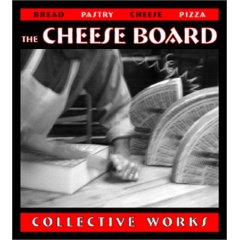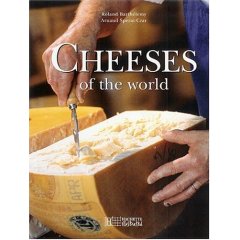
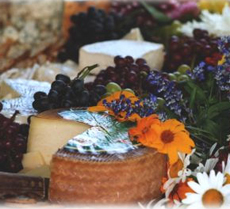
Is your cheese in season? It is, if you know when to buy. Photo Courtesy of The Ashby Inn.
June 2005
|
 |
Cheese Savvy
Facts and Fancies For Turophiles (That’s Cheese Lovers)
There’s lots to learn about cheese. There are numerous articles in this section of THE NIBBLE. Here’s a quick overview.
Categories Of Cheese
It is not easy to categorize cheese: many fall into multiple categories. For example, a blue cheese can be firm or semi-soft; made from cow, goat, or sheep milk; made from raw or pasteurized milk. However, one trait always defines it: the blue vein. For the sake of simplicity, we have divided the vast world of cheese into four principal categories with some sub-categories for a contextual reference.
1. Soft Cheese. This group includes two principle categories:
-
Fresh Cheeses. These are cheeses that have not been aged, or are very slightly cured, have a high moisture content and are usually mild with very creamy taste and soft texture. These may be made from all types of milk, and are generally ready to eat in a few hours. Examples include Cottage Cheese, Chevre, Cream Cheese, Farmer Cheese, Feta, Mascarpone, Mozzarella, Pot Cheese and Quark.
-
Soft-Ripened Cheeses or Bloomy Rind Cheeses. These cheeses ripen quickly from the outside in, are very soft and even runny at room temperature. The edible white rinds are produced by spraying the surface of the cheese with Penicillium candidum before the brief aging period. Examples include double-crèmes like Brie, Camembert and triple-crèmes like Brillat-Savarin and St. Andre, which are made with added cream).
2. Semi-Soft Cheeses. These cheeses that have a smooth, generally creamy interior with little or no rind. These cheeses are generally high in moisture content and range from very mild in flavor to very pungent. The category includes three groups:
- Mild semi-soft cheeses ripened by bacteria or yeast, such as Colby, Fontina, Havarti and Monterey Jack.
- Pungent semi-soft cheeses including many of the Washed Rind group, such as Epoisses, Livarot and Taleggio.
-
The blue-veined group, ripened by the Penicillium molds. This group includes Danish Blue (ripened by Penicillium roqueforti), Gorgonzola (Penicillium gorgonzola), Roquefort (Penicillium roqueforti), and Stilton (Penicillium glaucum). In addition to the blue veins, these molds provide a distinct flavor profile to the cheese, which ranges from fairly mild to assertive and pungent. Some blue veined cheeses can be found in the other categories as well, except for fresh cheeses.
3. Firm Cheeses. Originally referred to as farmhouse cheeses, firm cheeses span a broad spectrum with taste profiles that range from very mild to sharp and pungent. The category includes Cheddar, Edam, Emmenthaler (Swiss), Gouda, Jarlsberg, and many “tomme” styles. They can be aged from a few weeks to more than a year.
4. Hard Cheeses. These are the the longest aged cheeses with grainy textures, and are primarily intended for grating. The aging can take from one year to more than seven years. Examples include Asiago, Parmesan, Pecorino and Romano.
See the Glossary of Cheese Terms for more information.
The Calendar Determines the Most Flavorful Cheese
From the experts at Murray’s Cheese in New York City: The winter months always remind us of the changing of seasons and the lack of good fresh style cheeses, in particular goats. As with the first spring ramps, summer tomatoes, tiny, briny winter shrimp from coastal Maine, seasonality is a blessing and a curse. What makes these products special, and uniquely delicious, is their limited availability: when they are around, they are stupendous. A hothouse tomato is simply not the same as a sun-swollen summer fruit. Such is the case with cheese.
The logic is simple. Goat milk is often made into fresh style cheeses, or lactic curd, and the shelf life is inherently short. Goats mate in the fall, like most ungulates, and give birth in late winter. The consequence is an abundance of milk in early spring through fall. By early winter the animals stop producing milk and the cheeses follow suit. It is simple biology, but as humans, we love to fool with Mother Nature. Given the ever-shrinking size of the world, cheese from any corner of the world is available within 24 hours (more or less). In addition, we also have the recent technology of freezers to carry over the milk (actually curd) until the fresh runs out and the overseas markets are hungry for the fruits of summer in the middle of winter. These two factors are effectively used by many of the large goat producers to create year round income, and why not if there is a market?
Sheep fall into the same physiological category as goats but the cheeses are more often cooked curd and pressed, which have a much longer shelf life. Therefore the season seems longer. The difference in longevity by cheese type implies that the high moisture cheeses are often the “seasonal” types. The hard-pressed cheeses, having a longer shelf life, can be stored for the duration of the off-season. The big exception is the cow. Breeding cycles with cows have been altered so that any number of cows can give birth at different times to create a constant flow of milk.
|
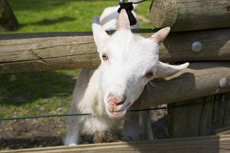 |
Oh you kid: baby goats are called kids,
females are called does, and males are called bucks. Here, a baby buck (you can tell by the horns). |
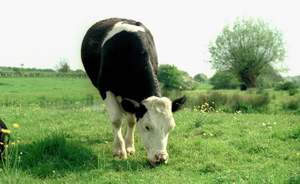
A “cash cow” indeed: unlike with sheep and goats, farmers
can alter the breeding cycles of cows. A steady steam of
calving means a constant flow of milk. With sheep and
goats, nature takes its course: lambs and kids are born in
the spring, starting the milk flow for cheese and other
products. Photo of a Holstein, courtesy of MorgueFile.com.
|
With artificial insemination being the most common form of reproduction on most dairy farms, the timing is all in the hands of the farmer. Consequently, this is what allows the farmer to control the cross breeding to ensure a good milking herd. The result: cow milk cheeses, soft and hard, are largely available year-round, though the flavors in the milk (and thus the cheese) are impacted by seasons beyond the control of any farmer.
|
When cows are grazing on lush pasturage, clover, herbs and flora, as is true in the abundance of warmer months, their milk is richer and deeper in flavor. So, then, is their cheese.
Ash or Cinder-Coated Cheeses
Some people may find it strange to coat one’s food with ashes, but as with most things, there’s a practical reason rooted in history. Goat cheeses are the most delicate, and the only ways to keep fresh cheeses at their best prior to refrigeration was to coat them: in salt, wax, or in ashes from the fireplace. (Today, vegetable ash from bell peppers, eggplants, or grape vines is used, and it is completely edible.)
While goat cheeses are the most common varieties to be coated in ash (Saint-Maure and Selles-sur-Cher are the two best known), cow and sheep milk cheeses such as Morbier or Mobay may have an inner ash layer across the horizontal axis. This is done not to protect the cheese, but to create a distinctive presentation and showcase the craft of the artisan.
Morbier, a semi-soft cheese from a small farm town in France, was originally made with leftover cheese for personal consumption by the cheesemakers. At the end of the day they would take leftover curd from making Gruyère de Comté and press it into a mold. To keep it from drying out and to keep the insects away, they would top it off with some ash. In the morning they would add any additional afternoon curd on top of the ash and voilà: Morbier. Mobay cheese, made from unpasteurized cow's milk contains a layer of ash to separate the first and second batch of curds used in the production of the cheese. Cypress Grove Chevre’s Humboldt Fog cheese is a goat’s milk cheese produced with an inner layer of ash separating the two layers. |
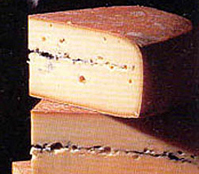
Morbier. Photo courtesy of FromagerieHamel.com. |
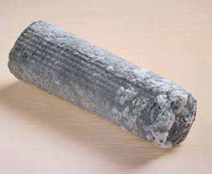 |
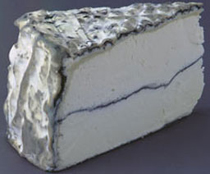 |
The familiar Saint Maure cinder log. Photo
courtesy of ToelzerKasladen.de. |
Humboldt Fog from Cypress Grove Chevre. Read our full review. |
Nibble Tip
Blue mold = good mold. If a blue mold develops on your cheese, it is good and natural (think blue cheese). You can eat it; or it you aren’t into blue, scrape it off and eat the rest of the cheese. Red or black mold, however, indicates a cheese that’s past its prime. Cut it away. |
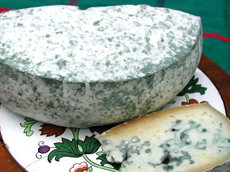 |
Here’s how to remember the rule: blue mold
is good, like the mold in blue cheese.
Photograph courtesy of Professor David B.
Fankhauser, U.C. Clermont College. To see
how Professor Clermont made this Saga-type
blue cheese, click here. |
Become A Cheese Guru
Delicious Anyway You Slice It
 |
 |
 |
| Chicago Cutlery Wine and Cheese Set: Perfect for a wine and cheese party, this eight-piece set features a series of cheese knives along with a serving fork, a corkscrew, a wine-bottle stopper, and a reversible cutting board. Click here for more information. |
Rotary Cheese Grater: Hand-held rotary cheese grater lets you grate at the table for the freshest, tastiest cheese. Click here for more information. |
Cheese Knives: Properly cutting cheese requires specialized tools, as any partygoer confronted by a wheel of Stilton and a butter knife knows. Click here for more information. |
Lifestyle Direct, Inc. All rights reserved. Specific sections of content are the copyright of their respective owners. Images are the copyright of their respective owners. 
|












